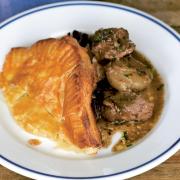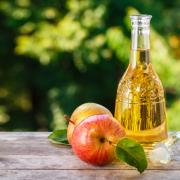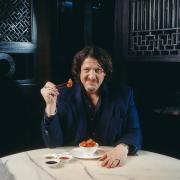Despite self-describing as “the least crafty person in the world”, TV presenter Kate Humble is a bit of a “fan girl” for anyone with the skills to craft things by hand.
“With the rise of AI and the whole workplace changing so quickly – if you’re a writer or photographer or in TV, AI can do all this s*** for us,” says the 55-year-old. “So there’s actually been a resurgence in people wanting to learn how to make things, build a drywall or do blacksmithery, because people are fearing that AI will take away white collar jobs.”
Even in the age of careers made entirely on the internet, “There might be a real artisan uprising”, she says, “which would be amazing”.
Humble, who has presented BBC’s Back To The Land, Springwatch and Animal Park, says she doesn’t have “the creative gene” but “I’m really good at manual labour, and my kind of creative side actually is with cooking”.
The author of several books, her latest, cookbook Home Made, celebrates the beauty of artisan, handmade products – all of which are used in food and cooking in some way. Stories of individual artisan makers of aprons, knives, firepits, and pans are weaved in around simple, countryside recipes inspired by those people and their products.

“A lot of people will say, ‘Well, if you buy beautiful, handmade, artisan stuff, it’s very expensive’, which is also true. However, it will often outlast anything that is mass-produced. So I think you buy things like that with a different mindset, of them being almost heritage pieces that you will keep forever and you will look after.
“If people go and buy lots of cheap clothes, they think it’s great, they’re cheap, but the expense to the planet is enormous. We’ve been pushed down a very virulent consumer route – which is buy, buy, buy.”
The people featured in the book – from glassmaker Emsie Sharp and basket weaver Amanda Rayner, to Ben Ward who gave up his office job to become a professional vegetable grower – are “incredibly inspiring but also relatable,” Humble says. “These are all just ordinary people who’ve made an extraordinary choice to kind of really follow their hearts and do something that they love and that they’re skilled at. Because it’s not the normal way of [doing] things nowadays.”
And there’s courage in pursuing that. “I hope it taps into everyone’s little brave bits of their heart and the free bits of their spirit – even if they don’t go off and whittle spoons forever.
After all, modern life is moving us further and further into what’s fast and convenient.
“We’ve become so disconnected with the whole process of food, even more so I think in the last sort of five years, with the rise of delivery companies that just deliver cooked food to a house. People are getting their supermarket shop delivered to their doors. So they’re not doing it. They’re not even choosing the fruit or the vegetables that they’re going to eat.”
She notes that stories of where ingredients have come from are often used by restaurants to make it more appealing. “They’re really keen to tell you it’s locally sourced, or the name of the farmer – as a selling technique. But we don’t do it ourselves.”
Humble learned how to cook from her mum. “I grew up in a household and in an era where people did cook. We didn’t have takeaways or deliveries – certainly not in the Seventies and not in the countryside. All the food that we cooked, my mum cooked from scratch and we grew a certain amount of vegetables.”
She describes herself as “not a proper cook, just a home cook” and she hopes her recipes reflect that. “They are super easy,” she says, “and I’m unapologetic about that. To me, cooking should be a pleasure, not something that’s scary or a trial or an endurance test.
“There’s something about cooking for me that is just very therapeutic. I don’t try and make anything that is really out of my comfort zone, I just think that is not what it’s about. I love the process of taking raw ingredients and transforming them in the most simple and uncomplicated but mindful way.”
Humble grew up in rural Berkshire and, back in 2007, moved from London to Wales to live on a smallholding with husband Ludo, and went on to set up a working farm in the Wye Valley – where Channel 5’s Escape To The Farm is filmed.
“I’m just not cut out for city living. It actually came into sharp focus when I was working on Springwatch, but still living in London. I loved doing Springwatch so much because I loved that reconnection with the process of spring. I loved the response of nature to the lengthening days and the temperature getting warmer – and I love being witness to that.
“And I realised how much I missed it. It was an inherent part of my childhood that I’d never really considered before.”
Moving, she says, brought her back to herself. “I found city life really difficult.”
Her life-long travel bug is deep-rooted, though. At 18 she was working in an office to save up to go to Africa and someone asked her why. “I just thought, there’s a whole world out there and I haven’t seen any of it yet. I was really surprised by the question.
“I hope I never get to the stage where I’m happy just to be in one place and work in the same place all the time. I know it suits some people, absolutely fine, but I didn’t want it to be me.
“I suppose I’ve always tried to engineer things are much as you ever can to lead a life that makes me happy and hopefully makes other people happy.
“My mum still thinks I’ve never had a proper job – which is sort of true, but, yeah, it suits me, and it’s just being true to yourself, really.
She gets “homesick” when she travels now though. “We live in such an extraordinary world full of incredible places and people and animals. I still have this real desire and joy to see it. But I also have this added element of really loving coming back.”
Home Made: Recipes From The Countryside by Kate Humble is published by Gaia, priced £26. Photography by Andrew Montgomery. Available now

Kate Humble’s autumn winter board recipe
The seasonal colours really make this dish.
Who says sharing boards only have to be cured meats and cheeses? Kate Humble’s version is a display of spiced, colourful fruits to finish off a meal.
And the best part is they don’t require much effort at all.
Autumn winter board
Ingredients
(Serves 4-6)
For the brown sugar meringues:
2 egg whites, at room temperature
¼ teaspoon lemon juice
150g light muscovado sugar, at room temperature
For the fruit board:
2 clementines, peeled and sliced horizontally
2 persimmons, sliced
A handful of blackberries
2 pears, quartered, cored and sliced
100g Physalis, in their husks
2 balls of stem ginger, plus 1tbsp syrup
150ml Greek yogurt
Zest of 1 unwaxed orange or 2 clementines
75g pomegranate seeds
Method
1. Preheat the oven to 120°C, Gas Mark ½, and line two baking trays with baking paper. In a large, very clean bowl, whisk the egg whites with a handheld electric whisk (or you can use a stand mixer) until frothy. Add the lemon juice and continue to whisk until doubled in size.
2. With the whisk still running, slowly add the sugar one spoonful at a time, whisking constantly until all the sugar has been added and you have reached a glossy stiff peak. Spoon the meringue mixture into a piping bag fitted with a one centimetre nozzle.
3. Secure the baking paper to the trays using a dot of meringue mix in each corner, then pipe meringue mix onto the trays at intervals, leaving a small gap between each. You are aiming for meringues that are about two centimetres wide at the base. To achieve a point at the top, pipe vertically down onto the tray, release the pressure and pull the piping bag upwards as you do so.
4. Bake for one hour in the oven. Then turn the oven off, leave the door ajar.
5. Once ready to serve, arrange all the fruit in a lovely pattern on a board, except for the pomegranate seeds, which you’ll use later.
6. Finely chop or grate the stem ginger balls and mix into the yogurt along with enough syrup to sweeten it to your liking. Dot the ginger yogurt over the fruit, or serve it in a small bowl for dipping.
7. Crumble the meringues over the top, then finish with a sprinkling of the orange zest and the pomegranate seeds.

Kate Humble’s cauliflower curry recipe
It’s cauliflower season and this recipe is warming and healthy for autumn/winter.
Kate Humble created this recipe after being inspired by professional vegetable grower and custodian of Moor Park Garden in Wales, Ben Ward.
Apparently cauliflowers are fiendishly tricky to grow though. “Luckily there is nothing tricky about this curry, which makes the most of the cauliflower’s ability to carry flavour,” says Humble.
Cauliflower Curry
Ingredients
(Serves 4)
1tbsp cumin seeds
1tbsp mustard seeds
4 curry leaf sprigs (optional)
1 red onion, thinly sliced
Flavourless oil or ghee
4cm piece of fresh root ginger, peeled and finely grated
4 garlic cloves, finely grated
2tbsp curry powder
450g tomatoes, chopped, or a 400g can of chopped tomatoes
1 cauliflower, cut into florets
250ml vegetable stock
Sea salt and freshly ground
Black pepper
A handful of fresh coriander, to garnish
Method
1. Heat a large saucepan over a medium heat.
2. Add the cumin and mustard seeds and the curry leaves, if using. Cook until the seeds start to pop, then immediately add the onion, a big pinch of salt and a glug of oil or 1 tablespoon of ghee and stir well. Cook over a medium-low heat for 10–15 minutes, until the onion is softened and turning golden.
3. Stir through the ginger and garlic and cook for a further minute. Then add the curry powder and stir through to mix.
4. Tip in the tomatoes with a pinch of salt and mix well. Cook for a further 5 minutes over a medium heat, until the tomatoes are collapsed and soft.
5. Stir through the cauliflower and another good pinch or 2 of salt, mixing really well so that all the florets are coated in the spices. Add the stock, cover and bring to a simmer.
6. Simmer for 15–20 minutes, stirring now and again, until the cauliflower is tender. Taste and adjust the seasoning if necessary.
7. Sprinkle the coriander on top and serve with steamed rice and mango chutney.

Kate Humble’s Thai-spiced fish stew recipe
Try this easy, nutritious and wholesome dish for colder weather.
“This is heaven in a bowl and needs no more introduction than that,” says Kate Humble.
Thai-spiced fish stew
Ingredients
(Serves 4)
300g firm white fish, cut into chunks
200g raw peeled king prawns
Flavourless oil, such as sunflower
2 lemon grass stalks, trimmed and bashed
3cm piece of fresh root ginger, peeled and finely chopped or grated
4 garlic cloves, sliced
3 spring onions, sliced
1 long red chilli, sliced
1tbsp tomato purée
150g cherry tomatoes, halved
160ml coconut cream
500ml fish or vegetable stock
1tbsp fish sauce
1tsp sugar
1tbsp tamarind paste
250g sugar snap peas
Leaves from a small bunch of Thai basil
Sea salt and freshly ground
Black pepper
Method
1. Put the fish and prawns into a bowl and sprinkle over 1 teaspoon of salt. Mix well and leave to one side for up to 1 hour.
2. Heat a large saucepan over a medium heat, add a dash of oil and stir the lemon grass, ginger, garlic, two-thirds of the spring onions and the chilli over the heat until the garlic turns light golden. Add the tomato purée and stir for a further minute.
3. Tip in the tomatoes, the coconut cream and the stock and mix to combine.
4. Then stir in the fish sauce, sugar and tamarind and bring to a gentle simmer for 10 minutes. Taste and adjust the seasoning, bearing in mind the fish with its salt will be added shortly. More fish sauce will give a saltier flavour, extra tamarind will increase the sour.
5. Add the fish, prawns and sugar snap peas and mix through. Simmer gently for a further 3–4 minutes, or until the fish is only just cooked through.
6. Remove the lemon grass stalks and discard. Serve in bowls, scattered with the basil and remaining spring onion.


























